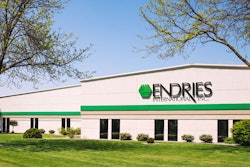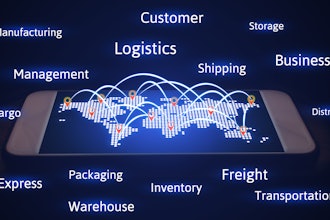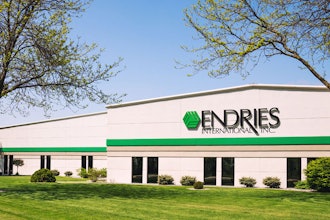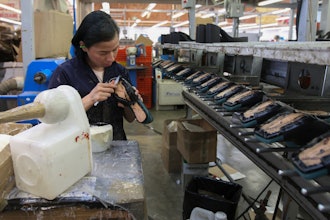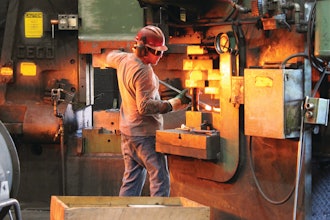It’s Under Your Feet and Helping Your Distribution Center More than You Probably Realize
If you work in a distribution center, you probably see one of these every day. In fact, you likely walk on one every day without giving it a second thought. And, even if you did see it or walk on it, very likely you do not realize all the benefits it offers. Further, this “mystery” we are talking about works on a 24/7 basis, helping to protect the health and safety of industrial workers.
So what’s the mystery? Floor mats.
It’s not that mats “don’t get no respect,” Rodney Dangerfield’s famous expression; it’s just that managers of many distribution and industrial centers do not realize how important mats are to the health of workers and the indoor environment. They may know that mats can help prevent a slip-and-fall accident during adverse weather but don’t understand exactly how. Additionally, some administrators may think of mats as just being installed at the building’s front door. But, there are many different types of mats used for a variety of situations, especially in an industrial location.
Free Whitepaper: 4 Signs Your Warehouse Needs a Barcoding System
Let’s start by discussing the health benefits of mats. Are you aware that a building cannot earn LEED certification — meaning it has shown that a number of green and sustainability programs are in place — without high-performance matting installed at all key building entries? The reason for this is actually very simple.
A high-performance mat helps prevent soils and moisture from being walked in to a facility. With less soil and moisture walked in, facilities stay cleaner and this typically means fewer cleaning chemicals, tools, and equipment are necessary. Whenever we reduce how often a facility needs to be cleaned, we reduce cleaning’s impact on the environment, which is one of the key goals in green cleaning and for a facility to be LEED certified.
Before we look into the many different types of mats, we need to define two words we have already used a few times: high-performance. A high-performance mat, as the name implies, is designed to be more effective and last longer than a typical mat. High-performance mats are invariably purchased from a supplier or directly from a manufacturer and are warrantied to last one to several years. A rental mat, on the other hand, may only last a few months, which is a reflection of the difference in quality and manufacturing.
Mats for Every Location
If your distribution center is involved with food-related products, laboratory items, or products or materials designed for use in a healthcare facility, then an anti-microbial mat should be considered. Anti-microbial mats are infused with an additive that inhibits the growth of germs and bacteria. This can be more important than we realize. Studies indicate we have as many as 50 direct and indirect contacts with floors every day. An example of indirect contact with a floor is picking up a box from the floor and touching the areas of the box that came in contact with the floor. If that surface has germs and bacteria on it, the chances they are now on our hands is fairly high. If we now touch our mouth, nose, eyes, or another surface, which is then touched by someone else, we have the beginnings of cross contamination. Because an anti-microbial mat impedes the growth of organisms, it helps reduce the possibility of cross contamination.
Mats are invariably called into service during adverse or wet weather. They help prevent slip and fall accidents by removing moisture from shoe bottoms. But did you know there are floor mats made for very heavy foot traffic — as many as 1,500 people per day — that hold up to two gallons of water per square yard? That’s a lot of water and it is helping to protect the health and safety of a lot of people.
These mats typically have a bi-level pattern. This helps the mat withstand heavy foot traffic, but it also allows moisture to drain below the mat; this is important and it is why bi-level mats should be considered, especially during adverse weather. The mat can become saturated with moisture and soil to the point where instead of wiping it off shoe bottoms, it reattaches soil and moisture to shoe bottoms. When this happens, not only is there a greater chance of a slip and fall accident, but the moisture and soil are now tracked in to the facility — a bi-level mat helps prevent this.
Are there workers in your distribution center that stand for long periods at one workstation? If so, there is one more mat we need to discuss, and that is anti-fatigue matting. The issue at hand is standing on a flat surface for many hours of the day starts to cause pain in lower extremities. On top of this, it can negatively impact blood flow and the amount of oxygen carried in the blood. An anti-fatigue mat is designed to provide a slight but definite “bounce.” This bounce helps reduce musculoskeletal pain and fatigue. More advanced anti-fatigue mats are made with a patented foam called Zedlan, which has been found to be more effective than other types of foam products used in anti-fatigue mats. These mats help increase blood flow, which reduces fatigue and pain, which in turn improves worker productivity and morale.
The Floor Audit
When a facility decides it is time to invest in high-performance mats, they often call in an astute distributor who conducts a floor audit. Very simply, the distributor walks through the entire location, outlining where mats should be installed and what types. And by the way, there are many more types of mats than we had a chance to discuss here so a distributor that knows mats can prove very helpful in product selection.
If performed properly, the end result is a healthier, safer, and cleaner work area…and possibly a lot more respect for all that mats do.
Mat Tips:
- Mats should always be placed directly next to the door. And if one mat is followed by another mat, the two mats should touch.
- There are three types of mats used at building entries: scrapers, wiper/scrapers, and wipers. The three mats work together to help remove soils and keep facilities clean.
- Rental mats are often very light so they can easily fold. But, this means they can lose their placement, absorbency, and effectiveness. A heavier high-performance mat will likely hold its position, remain flat, and have greater absorbency.
- In the mat world, we talk about the “Rule of 15s.” This indicates that at least 15 feet of matting should be installed at entry doors — five feet each of scraper, wiper/scraper, and wiper mats; this keeps moisture and soil out and promotes safety.
- Mats should be vacuumed regularly throughout the day and cleaned using the carpet extraction method on a regular basis.
- If storing mats, do not roll or fold them; this can damage or weaken the backing of the mat and cause curling. Instead, lay them flat, one on top of another until needed.
Adam Strizzi is marketing manager for Crown Matting Technologies, one of the oldest and largest manufacturers of matting products in the United States. He can be reached via his company website at www.crown-mats.com.







